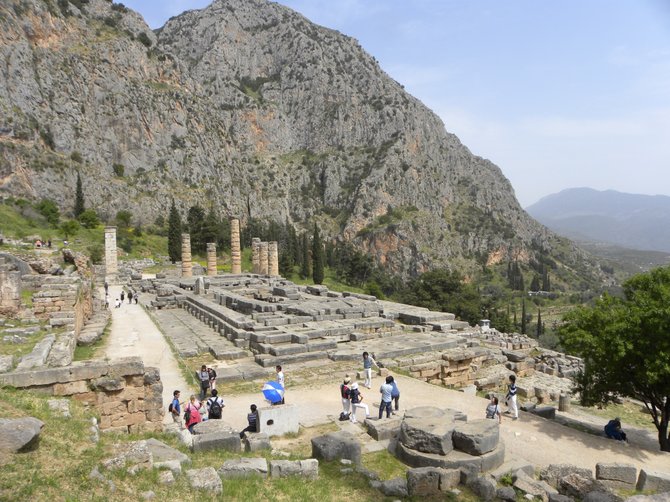 Facebook
Facebook
 X
X
 Instagram
Instagram
 TikTok
TikTok
 Youtube
Youtube

I have a confession: I’m crazed about the ancient fortune-telling sibyls.
So crazed that I’ve raced through the Vatican to see Michelangelo’s depiction of the sibyls on the Sistine Chapel and I’ve even flown to Athens, Greece, rented a car, and driven out to the sibyls’ most famed residence. Why the fascination? Is it because I have a fuming question that could restore or save man’s future?
Located close to the Corinthian Gulf, Delphi is about a two-hour drive from Athens. According to legend, Apollo slew the mythical Python dragon here, throwing its body into a crack in the earth, which then forever plumed with nauseous gases.
Another myth says that a Delphic sibyl – the daughter of Apollo – lived here and prophesized the coming of Christ. While her existence is questionable, ancient writers did describe priestesses known as Pythias who lived in Delphi from the 8th century B.C. to the 4th century A.D.
According to the Greek historian Plutarch, the Pythias owned property, were exempt from taxes, received free room and board, and made a large stipend. Unusual for the male-dominated ancient world, these women sat in an adyton of the Apollo temple, breathing fumes that made them go into a frenzy and utter crazed predictions about the future. Their work would leave them as depleted as athletes after a race.
Interestingly, in 2001 Geology reported that ethane, methane and ethylene gases were found in spring water located near the oracle. Ethylene, in particular, is known to produce euphoric effects. The findings gave credence to the ancient records.
Men came from throughout the Greek world to consult the Pythias. Delphi, over time, also served as a de facto bank for cities that left their valuables in vaults along the steps going up to the Temple of Apollo.
The Delphi archeological site today has a museum that displays some of these riches, including a silver- and gold-plated bull statue from the 6th century B.C. From the museum, visitors walk up a steep hill, passing the marble vaults – now empty – until they reach the Temple of Apollo. Now merely flattened blocks of massive stone with a few standing columns, the temple is wedged into Mount Parnassus and overlooks a breathtaking valley.
Walking up above the temple, there’s a theater and even further up a stadium that once held the Pythian Games. Trekking back down the hill and along a road for about a half-mile, visitors can also see the sanctuary of Athena. The ruins stretch out so far that it’s easy to imagine a bustling ancient city.
So what about the sibyl or the Pythias, and their predictions? While standing by the Apollo Temple, my mind whirled and I thought quickly, hoping a female’s prophesy could once again save men from their errors.
I asked out loud: “Will the European man-bag ever go out of style?”
The answer, I believe, blew down from Mount Parnassus and away into the valley.


I have a confession: I’m crazed about the ancient fortune-telling sibyls.
So crazed that I’ve raced through the Vatican to see Michelangelo’s depiction of the sibyls on the Sistine Chapel and I’ve even flown to Athens, Greece, rented a car, and driven out to the sibyls’ most famed residence. Why the fascination? Is it because I have a fuming question that could restore or save man’s future?
Located close to the Corinthian Gulf, Delphi is about a two-hour drive from Athens. According to legend, Apollo slew the mythical Python dragon here, throwing its body into a crack in the earth, which then forever plumed with nauseous gases.
Another myth says that a Delphic sibyl – the daughter of Apollo – lived here and prophesized the coming of Christ. While her existence is questionable, ancient writers did describe priestesses known as Pythias who lived in Delphi from the 8th century B.C. to the 4th century A.D.
According to the Greek historian Plutarch, the Pythias owned property, were exempt from taxes, received free room and board, and made a large stipend. Unusual for the male-dominated ancient world, these women sat in an adyton of the Apollo temple, breathing fumes that made them go into a frenzy and utter crazed predictions about the future. Their work would leave them as depleted as athletes after a race.
Interestingly, in 2001 Geology reported that ethane, methane and ethylene gases were found in spring water located near the oracle. Ethylene, in particular, is known to produce euphoric effects. The findings gave credence to the ancient records.
Men came from throughout the Greek world to consult the Pythias. Delphi, over time, also served as a de facto bank for cities that left their valuables in vaults along the steps going up to the Temple of Apollo.
The Delphi archeological site today has a museum that displays some of these riches, including a silver- and gold-plated bull statue from the 6th century B.C. From the museum, visitors walk up a steep hill, passing the marble vaults – now empty – until they reach the Temple of Apollo. Now merely flattened blocks of massive stone with a few standing columns, the temple is wedged into Mount Parnassus and overlooks a breathtaking valley.
Walking up above the temple, there’s a theater and even further up a stadium that once held the Pythian Games. Trekking back down the hill and along a road for about a half-mile, visitors can also see the sanctuary of Athena. The ruins stretch out so far that it’s easy to imagine a bustling ancient city.
So what about the sibyl or the Pythias, and their predictions? While standing by the Apollo Temple, my mind whirled and I thought quickly, hoping a female’s prophesy could once again save men from their errors.
I asked out loud: “Will the European man-bag ever go out of style?”
The answer, I believe, blew down from Mount Parnassus and away into the valley.
Comments